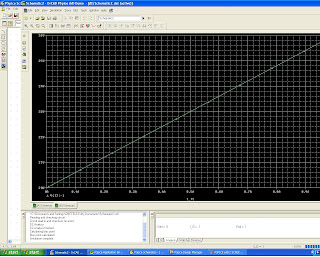The second PSPICE lab is designed to test some applications of the P SPICE engineering simulation software. The first lab was more to familiarize people with the Graphical User Interface of the program. One of the core concepts to take away from the PSPICE LAB #2 is that the program is intended to provide engineers with a quick way to design and test various designs. It would be impractical to build a prototype for every single theory or design and so P SPICE is used as an intermediate in order to separate the designs that are theoretically sound enough for Prototypes.
The Circuit on the right was created in PSPICE Schematics and involved use Viewpoints which are a neat tool to set PSPICE to display any electrical information at a point on the circuit designated by the user.
The Graph on the Right is an example of the type of graphing capabilities possible with the software. A varying voltage source which varies between 1-20 Volts at 1 Volt Increments is used as an example.
For more complex analysis involving dependent sources like the circuit on the left.
The following graph maps various factors and values.
Consequently, to figure the Norton Current, a probing voltage source is put in place of the load. The idea is to set an artificial voltage across the load and figure out the current across that voltage source.
The circuit on the left here is meant to be the thevinin representation of a more complex circuit. PSPICE can also calculate a variety of different capabilities of a given circuit including the maximum power dissipation when facing a varying load capacity.
The following power graph is a trace of the values of the power dissipated across the load at various resistance levels.
PSPICE's ability to quickly analyze a circuit with sweeping loads and source values is a valuable tool for the electrical engineer. Not only does it provide a quick way to calculate Norton and Thevinin values, it is also a way of calculating the values across a circuit under various conditions. Analysis of these graphs provide engineers with a way of seeing the best ways to implement a circuit design.













